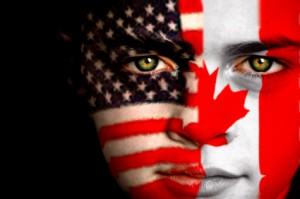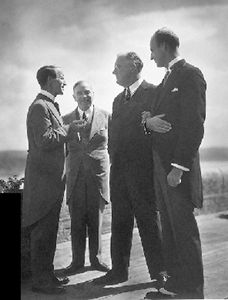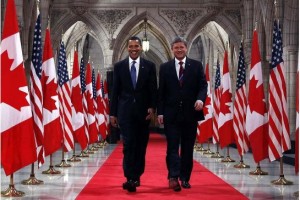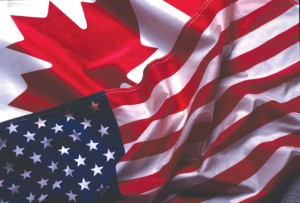Canada Day is July 1st; United States Independence Day is July 4th. To celebrate both birthdays I’m taking a step away from the usual business and communications issues for some fun facts and stories about Canada and the United States – assembled here by someone who has lived 30 years in Canada and 20 years in the United States.
There is more texture and context to our two nations’ relationship than simply the longest undefended border in the world, “healthcare” or “guns.”
On both sides of the border a little knowledge and context can’t hurt – Americans and Canadians might each want to think about our two nations as more than just neighbours/neighbors as ultimately we are also best friends, despite the occasional difficulty or irritant.
Sometimes we merrily go along with “preconceived” notions about each other, rather than thinking of a “fuller perspective.” Stephen Leacock in his book “Sunshine Sketches” (published 80 years ago) wrote of his near perfect, idyllic, little Canadian town – Mariposa. Everyone and everything was nice, kind and gentle – an ideal community. Two years later, he wrote “Arcadian Adventures” – about an American town that is a far from perfect –individualism was the Holy Grail; people were obsessed with the mechanical and the material. Leacock’s satire has become our stereotypes, even though it is both out dated and wrong — on both sides of the border.
The earliest of times had our two countries viewing each other with suspicion and fear. In fact, some argue Canada was born partially out of fear that the US army after the civil war might well be up for invading Canada. There was some historical rationale:
- John Adams had noted in 1776, The Unanimous Voice of the Continent is “Canada must be ours; Quebec must be taken.” And, Thomas Jefferson said, “The acquisition of Canada this year, as far as the neighborhood of Quebec, will be a mere matter of marching, and will give us experience for the attack of Halifax the next, and the final expulsion of England from the American continent” in his letters in 1812.
Worth noting as a Canadian child I was taught Canadians won the War of 1812…say no more.
But over time, and with Canada establishing itself as a country, those threats and fear gave way. As Henry Kissinger once noted about Canada and the United States “[that we ] are doomed by geography and history to friendship”. I don’t think we were “doomed” although history and geography sort of forced things along.
Today, the Canada-U.S. relationship is governed by some 200 treaties and agreements that provide a solid legal basis for Canada–U.S cooperation on everything from defense to stewardship of the environment to our trade relationship and management of the border.
Joint Defense of North America Born in WW II: In August, 1940, the Ogdensberg Agreement was signed , near Ogdensberg New York, by Prime Minister William Lyon  Mackenzie King (a character if there ever was one, ) and President Franklin Roosevelt. It basically outlines a permanent plan for mutual defense of the two countries. Why? Everyone was fearful of Great Britain falling to the Nazis. Britain was already transferring gold reserves to Canada; there were plans to evacuate the Royal family, the government and as many critical military and scientific personnel to Canada if the UK fell to Germany. Both Canada and the United States recognized that this made Canada a target for the Nazi’s too. Canada and US came together to establish a board to oversee North American defense that ultimately lead to NORAD and more.
Mackenzie King (a character if there ever was one, ) and President Franklin Roosevelt. It basically outlines a permanent plan for mutual defense of the two countries. Why? Everyone was fearful of Great Britain falling to the Nazis. Britain was already transferring gold reserves to Canada; there were plans to evacuate the Royal family, the government and as many critical military and scientific personnel to Canada if the UK fell to Germany. Both Canada and the United States recognized that this made Canada a target for the Nazi’s too. Canada and US came together to establish a board to oversee North American defense that ultimately lead to NORAD and more.
- On 9/11, not only did Canada act in tandem with the United States to help secure borders and close airspace, one of the little known facts of that day is that a Canadian, General Findley, was in command of North American Air Defense. When the President of the United States of America ordered military jets to be scrambled to protect airspace or shoot down any other possible hijacked airliners, a Canadian military officer was in operational control.
- The Canadian Caper had much to do with the long time friendship and US-Canada relationship as Canada spirited diplomats out of Iran.
Economics: The Canada-US Relationship has been an example to the world, in many respects. Winston Churchill, referencing dark days of 1939 noted, “The long frontier from the Atlantic to Pacific Oceans, guarded only by neighborly respect and honourable obligations, is an example to every country and a pattern for the future of the world.”
- in 1986 the two countries did just that, as they jumped to the forefront of trade liberalization and set a model for subsequent trade liberalization directions and protocols, generally. Prime Minister Brian Mulroney of Canada proposed the two countries enter into a Free Trade Agreement, negotiations commenced and an agreement was reached in 1987. It went on to form the basis for NAFTA and by all accounts has been a tremendous success. In my personal opinion, Canada grew up and reached “adulthood” with this move.
- At 5,500 miles the Canada-US border is “the longest, undefended border in the world” – it’s even longer in Canadian measured kilometers (about 8000 kilometers). It is a border where a truck crosses it every two and a half seconds. The Ambassador Bridge connecting Detroit, Michigan with Windsor, Ontario, is the busiest international border crossing in North America in terms of trade volume: more than 25 percent of all merchandise trade between the United States and Canada crosses the bridge.
- Over 8 million U.S. jobs depend on trade and investment with Canada; Canada is the top export destination for 38 states
- Not the Middle East, but Canada, is the United States’ largest and most secure supplier of energy: oil, natural gas, electricity and nuclear fuel. And here the outgoing US ambassador talks about this importance. And here is the info on the next US Ambassador to Canada.
- And Canada is no longer just a resource provider…its home to lots of great and emerging high tech start ups, including in the social space — too many for me to start listing here…take a look at this infographic about Canadian technology adoption too — such as leading adoption of Google+ and more.
 “Shared history, shared borders — they are the foundation of our unique and intensely productive relationship, an alliance the likes of which the world has really never seen before.”
“Shared history, shared borders — they are the foundation of our unique and intensely productive relationship, an alliance the likes of which the world has really never seen before.”
President Clinton, Remarks at a Luncheon, Ottawa, February 23, 1995
Politics: President and Prime Minister Relationships: There is a long standing history between our political leaders of working together…or trying too; sometimes good, sometimes tough going. For my American friends, important to understand, there is a “tradition” and Canadian expectation that any President’s first foreign trip or leadership meeting should be with the Canadian Prime Minister…confirmed here by the current U.S. President:
“I came to Canada on my first trip as president to underscore the closeness and importance of the relationship between our two nations, and to reaffirm the commitment of the United States to work with friends and partners to meet the common challenges of our time. As neighbors, we are so closely linked that sometimes we may have a tendency to take our relationship for granted, but the very success of our friendship throughout history demands that we renew and deepen our cooperation here in the 21st century.” President Barack Obama, 19 February 2009.
By the account of the American State Department the two current leaders have met 13 times (including their one-on-one get meetings at various Summits).
Here are some Prime Minister-President stories, for fun
Franklin Roosevelt and Mackenzie King: the longest serving President and Prime Minister set the standard for friendship. Worth noting that President Franklin Roosevelt’s family summer home on Campobella Island in Canada is today an International Park Commission site.
Relations between Diefenbaker and Kennedy were not good. As the Cuban missile crisis played out they became even worse and while the prime minister had been inclined to accept nuclear warheads on Canadian soil, he changed his mind, reminding the American ambassador that briefing notes left behind by Kennedy had talked of “pushing” the Prime Minister on various issues. Kennedy also pronounced Diefenbaker’s name incorrectly and snubbed him in several other ways. Jackie Kennedy referred to the Canadian PM as a bore. At one point Diefenbaker said of Kennedy: “He’s a hothead. He’s a fool — too young, too brash, too inexperienced, and a boastful son of a bitch!”
Nixon called Pierre Trudeau an “asshole” on one of the Watergate tapes. Also, reportedly after a meeting between the two, Nixon said of Trudeau “he’s a clever son of a bitch…what was he talking about?” Classic Prime Minister Trudeau was unfazed. The prime minister responded, “I’ve been called worse things by better people.”
Brian Mulroney and Ronald Reagan got along like old and best friends. At their first meeting the two leaders ended up singing “when Irish Eyes are smiling” at a gala during their first summit to kick off a reinvigorated and new friendship.
Mulroney and George H.W. Bush went on to maintain a strong relationship, ratifying and implementing the free trade agreement. Bush and Mulroney shared ”a close similarity of views …on world affairs and a kind of unique personal closeness and frankness in exchanging views,” Scowcroft told reporters.…while even occasionally doing some business and fishing together at Kennebunkport.
And then there are…the People: more importantly than any agreements there is also an underlying friendship. Many of us have relatives or friends, business colleagues and associates across the border. And a lot of us cross the border: some 400,000 a day — what looks like hundreds of locales.
In a 1936 visit to Quebec City, President Franklin Roosevelt said, “when I have been in Canada, I have never heard a Canadian refer to an American as a “foreigner.” He is just an “American.” And, in the same way, in the United States, Canadians are not “foreigners,” they are “Canadians.” That simple little distinction illustrates to me better than anything else the relationship between our two countries.”
Canadians tend to believe that they are more informed about their American neighbours, than Americans are about them. In fact, that may be true. It helps that 90% of Canadians live within a couple hundred miles of the US border with access to American media, yet 90% of Americans live beyond those couple hundred miles of border.
At one border crossing between British Columbia and Washington State, etched in the concrete monument is a proclamation that takes that special relationship between two peoples to another level, beyond friendship, to that of being family. It says Canada and the United States “are children of a common mother”
Anthony DePalma reflects on the border after his assignment by The New York Time’s to Toronto, saying the caution and defensiveness about the border that he developed in Mexico evaporated in Toronto. However, with time in Canada he came to appreciate the northern border’s complexity because of its “ubiquitiously dual nature.” He notes that for Americans the border is almost invisible. Canadians, on the other hand, are painfully conscious of it all the time.
DePalma points out that Americans see the border as the line joining our countries. For Canadians it is the last line separating us from them.
Whatever that border is…or you think it is, there is a rich history and togetherness of our two countries and we would all do well to understand and put things in more context, more often…Im thinking.
 So, as two separate countries and people celebrate our nations’ birthdays, within a week of each other, I will be thinking we are both more complex and wonderful than our stereotypes suggest — it is a complex, interesting, dynamic friendship between two nations and two peoples…the original “new world” democracies, blazing ahead together, sometimes in spite of our foibles.
So, as two separate countries and people celebrate our nations’ birthdays, within a week of each other, I will be thinking we are both more complex and wonderful than our stereotypes suggest — it is a complex, interesting, dynamic friendship between two nations and two peoples…the original “new world” democracies, blazing ahead together, sometimes in spite of our foibles.
Note: this post is not just inspired by my personal experience as a Canadian who is now and American, but by several others, who along the way, taught me about needing to think beyond our stereotypes of our two countries and grow together…afterall, we share the continent together and are “the new world” in a different sort of way…
Mr. Binhammer, a well-done post from someone with a keen sense of both observation and history. I’ve long contemplated the deeper meaning of the July 1-July 4 holidays, and here you help put them into insightful perspective.
Mr DePalma, I enjoyed your book when it was published and still enjoy re-reading parts of it. I think it is an amazing perspective on the continent and our two countries. I appreciate your stopping by to comment.
It was a great pleasure to discover your site. I hope you will keep up the good work.
Bonus link here: this is funny and insightful: http://www.thisamericanlife.org/radio-archives/episode/65/Whos-Canadian